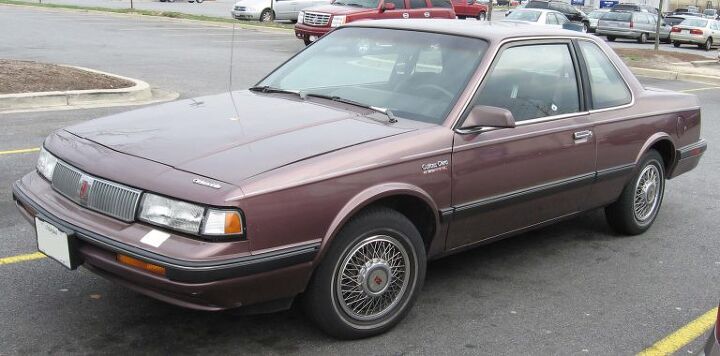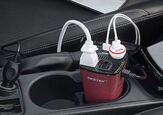Government Never Forgets: GM to Pay Back Cash That Funded Celebrity, Cutlass Ciera Production

A bill for the assembly of two decades-old models — one from a defunct marque — will come due on April 1. And unlike much of the debts written off during General Motors’ bankruptcy, a major subsidiary now has to pay this chunk back.
The money, $220 million in all, was handed to GM Canada back in 1987 to save the Montreal-area Sainte-Thérèse Assembly plant. GM Canada used that bankroll to build the stunningly sexy Chevrolet Celebrity and Oldsmobile Cutlass Ciera. It later cranked out the last Pontiac Firebirds and fourth-generation Chevrolet Camaros.
The thing about 30-year interest-free loans is that someone eventually comes to collect.
Unlike its parent company, outstanding loans held by GM Canada prior to 2009 are still active. During GM’s bankruptcy, its Canadian division slashed its workforce and dealer network in a desperate effort to reduce costs. Things improved, but media north of the border soon began asking questions about taxpayer cash handed out long ago.
GM Canada still intended to repay the $220 million offered up by the Canadian and Quebec government, the company said in 2011. The plant, of course, no longer existed, having been torn down and the land since turned into a big-box retail mall.
Sainte-Thérèse Assembly opened in 1965, building Chevrolet Biscaynes before moving on to H- and G-body vehicles in the 1970s and ’80s. When poor quality and labor strife threatened to shutter the facility, the federal and provincial government intervened. Each offered $110 million. It was then decided the plant should be retooled to build Chevrolet Celebrity and Oldsmobile Cutlass Ciera models. After that, another reprieve — Camaro and Firebird production ran from 1993 to 2002.
After that, GM left Quebec.
Following the most recent round of labor negotiations, GM pledged $554 million for its Canadian operations. While the possibility of government cash arose, last month GM said it wasn’t necessary for the projects it had in mind. While discussing the matter with the Globe and Mail, GM Canada president Stephen Carlisle claimed the company would indeed pay back the loan on its due date — April 1, 2017.
The payment comes at an opportune time for Canada, which just pledged an interest-free loan to another crucial Montreal-area business apparently in need of propping up.
(While editing this piece, Steph asked, “Oh, can you add the adjective ‘stunningly sexy’ before the first mention of Cutlass Ciera?” I was happy to oblige. —Mark)

More by Steph Willems
Latest Car Reviews
Read moreLatest Product Reviews
Read moreRecent Comments
- 28-Cars-Later “1. The Industrial Revolution and its consequences have been a disaster for the human race. They have greatly increased the life-expectancy of those of us who live in “advanced” countries, but they have destabilized society, have made life unfulfilling, have subjected human beings to indignities, have led to widespread psychological suffering (in the Third World to physical suffering as well) and have inflicted severe damage on the natural world. The continued development of technology will worsen the situation. It will certainly subject human beings to greater indignities and inflict greater damage on the natural world, it will probably lead to greater social disruption and psychological suffering, and it may lead to increased physical suffering even in “advanced” countries....It would be better to dump the whole stinking system and take the consequences”― Theodore J. Kaczynski, Ph.D., Industrial Society and Its Future, 1995.
- FreedMike "Automotive connectivity has clearly been a net negative for the end user..."Really? Here's a list of all the net negatives for me:1) Instead of lugging around a road atlas or smaller maps that do nothing but distract me from driving, and don't tell me where to go once I've reached Point B, I can now just ask my car's navigation system to navigate me there. It'll even tell me how long it will take given current traffic conditions. 2) Instead of lugging around a box of a dozen or so cassette tapes that do nothing but distract me from driving, I can now just punch up a virtually endless library of music, podcasts, or audiobooks on the screen, push a button, and play them. 3) I can tell my car, "call (insert name here)" and the call is made without taking my hands off the wheel.4) I can tell my car, "text (insert name here)" and the system takes my dictation, sends me the text, and reads off any replies. 5) I can order up food on my screen, show up at the restaurant, and they'll have it waiting for me. 6) I can pull up a weather map that allows me to see things like hailstorms in my path. 7) If I'm in trouble, I can push a "SOS" button and help will be sent. 8) Using my phone, I can locate my car on a map and navigate to it on foot, and tell it to turn on the heat, A/C, or defrosters.None of these are benefits? Sorry, not sorry...I like them all. Why wouldn't I? Consumers clearly also like this stuff, and if they didn't, none of it would be included in cars. Now, maybe Matt doesn't find these to be beneficial. Fair enough! But he should not declare these things as a "net negative" for the rest of us. That's presumption. So...given all that, what's the answer here? Matt seems to think the answer is to "unplug" and go back to paper maps, boxes of music, and all that. Again, if that's Matt's bag, then fair enough. I mean, I've been there, and honestly, I don't want to go back, but if that's his bag, then go with God, I guess. But this isn't the solution for everyone, and saying otherwise is presumption. Here's a solution that DOES work for everyone: instead of throwing the baby out with the bathwater, clean the bathwater. You do that very, very simply: require clear, easy-to-understand disclosure of data sharing that happens as the result of all these connected services, and an equally clear, easy-to-understand method for opting out of said data sharing. That works better than turning the clock back to those thrilling days of 1990 when you had to refer to handwritten notes to get you to your date's house, or ripping SIM cards out of your car.
- Funky D What is the over-under for number of recalls in the first 5 years of ownership?
- Normie Dayyum! Great White Woman!The car, I mean. I could feel kinda safe in it.
- Slavuta "The telescreen received and transmitted simultaneously. Any sound that Winston made, above the level of a very low whisper, would be picked up by it; moreover, so long as he remained within the field of vision which the metal plaque commanded, he could be seen as well as heard. There was of course no way of knowing whether you were being watched at any given moment. " --- 1984


































Comments
Join the conversation
My dad bought a Ciera new in 83. For it's time, it was a good car. We never had reliability problems with it, but it did like to eat front brakes. Gave great gas mileage too, one highway trip we averaged 39 mpg with the 2.8 V6. Speed limit was 90 km/h which helped, but it was always an economical car to drive.
I had a string of three of these Cutlass's as company cars An 85, 88, and 90. The 88 was the same color as the coupe pictured. The 88 was the best one of all. It was outfitted with handling suspension, aluminium wheels, and the 3.8 V6. It would smoke the front tires.